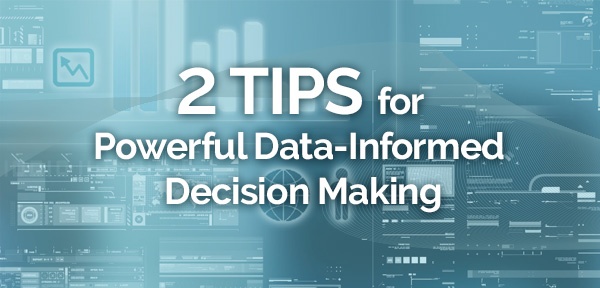Share this
Tips for Powerful Data-Informed Decision Making
by Core Solutions on January 4, 2016

Technology-enabled business models are more likely to be successful in the new world order, due largely in part to their ability to capture information and capitalize on data-informed decision making (DIDM). This type of decision making means you must take action, and for behavioral health and human service organizations that leverage this opportunity, success is bound to follow.
The two key components to achieve powerful decision making are understanding the difference between data-informed and data-driven and knowing how to nurture the data for success.
- Data-Informed vs. Data-Driven
The difference between being data-informed and data-driven is simple. It’s realizing that the data your organization has captured is merely a reflection of the strategy you already have in place based upon your current patient-base and their behaviors.Being data-informed means you acknowledge that your data is based on a snapshot of quality variables that can yield improvements, but don’t yet have enough data to determine the best solution in the biggest market. In contrast, if your decisions are data-driven, your outcomes will likely be biased due to the occurrence of “shallow data.” Understanding how these decisions differentiate will set your organization up for strategic excellence now and in the future. - Nurturing Data for Success
With an EHR system in place, your organization can capture and pivot data for a near-limitless number of variables. The data, however, needs to be nurtured rather than accepted at face-value for all of your organization’s key stakeholders including competitors, partners, society, donors and funders.It’s critical to explore your data by asking questions and interacting with the results to discover patterns. Then, leverage the predictive insights garnered to determine what is driving each behavior and outcome. This will lead to your next step of packaging the data into dashboards and infographics that can be easily understood to empower your staff. Once the data-informed insights are communicated with others, your leadership can fine-tune the data to gain new perspectives for your business relating to human behavior and interactions.“Think of data, and using data as the driver in the behavior modification business,” explains Ravi Ganesan, Chief Executive Officer of Core Solutions, Inc. “[Organizations] leverage data to create success, dramatically shortening cycles, and the competition is now someone you don’t know yet. Technology enabled businesses are the more likely to be successful in this environment.”
Share this
- April 2024 (2)
- March 2024 (4)
- February 2024 (1)
- October 2023 (3)
- September 2023 (3)
- August 2023 (2)
- June 2023 (2)
- May 2023 (3)
- April 2023 (4)
- March 2023 (2)
- November 2022 (3)
- October 2022 (1)
- September 2022 (1)
- August 2022 (3)
- July 2022 (1)
- June 2022 (1)
- January 2022 (2)
- December 2021 (1)
- October 2021 (2)
- September 2021 (2)
- August 2021 (2)
- July 2021 (5)
- June 2021 (5)
- March 2021 (2)
- January 2020 (3)
- November 2019 (3)
- October 2019 (2)
- July 2019 (1)
- June 2019 (1)
- May 2019 (1)
- April 2019 (3)
- October 2018 (1)
- September 2018 (1)
- August 2018 (1)
- July 2018 (1)
- June 2018 (1)
- May 2018 (2)
- April 2018 (1)
- March 2018 (1)
- December 2017 (1)
- October 2017 (2)
- September 2017 (1)
- June 2017 (2)
- May 2017 (2)
- April 2017 (1)
- February 2017 (2)
- January 2017 (3)
- November 2016 (2)
- October 2016 (3)
- September 2016 (2)
- August 2016 (1)
- July 2016 (2)
- June 2016 (1)
- May 2016 (3)
- April 2016 (2)
- March 2016 (2)
- February 2016 (2)
- January 2016 (3)
- December 2015 (2)
- November 2015 (4)
- October 2015 (3)
- September 2015 (4)
- August 2015 (1)
Subscribe by email


Let us know what you think